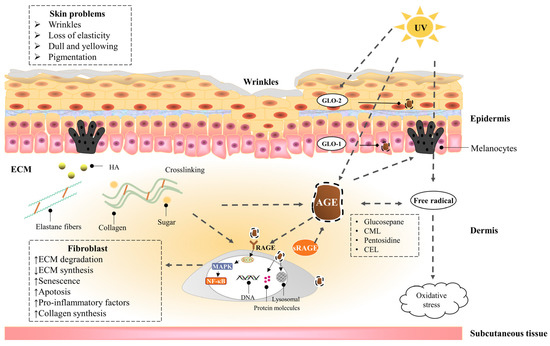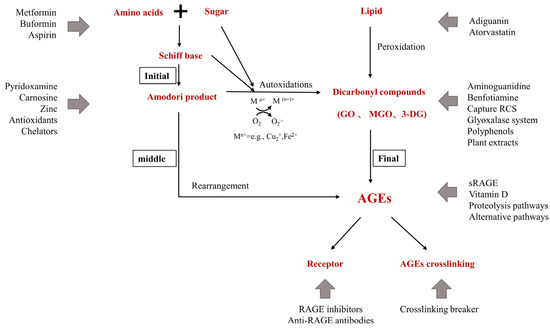Your browser does not fully support modern features. Please upgrade for a smoother experience.
Please note this is an old version of this entry, which may differ significantly from the current revision.
Subjects:
Dermatology
皮肤糖化是蛋白质(例如真皮胶原蛋白和天然还原糖)之间的非酶促反应,是内源性皮肤老化的基本根本原因之一。在反应过程中,在不同反应阶段和途径产生的一系列复杂的糖基化产物通常统称为晚期糖基化终产物(AGEs)。AGEs通过细胞内分子的修饰引起细胞功能障碍,并随着年龄的增长在组织中积累。AGEs还与多种与年龄有关的疾病有关,如糖尿病,心血管疾病,肾衰竭(尿毒症)和阿尔茨海默病。AGEs随着年龄的增长在皮肤中积累,并通过紫外线辐射等外源性因素放大,导致皱纹,弹性丧失,暗淡发黄和其他皮肤问题。
- skin glycation
- anti-glycation
- AGEs inhibitors
1. The Hazards of Skin Glycation
1.1. The Harm of High Glucose to the Skin
Glycation is an aging reaction of naturally occurring sugars and dermal proteins [46], which begins in early life, develops clinical symptoms at around 30, and progressively accumulates in tissues and skin due to the glycated collagens that are difficult to be decomposed [47]. AGEs derived from natural sugars (such as glyceraldehyde-3-PO4, glucose-6-PO4, and fructose) are formed several times faster than AGEs derived from glucose. Thus, glucose is the main source of energy for mammalian cells, fueling glycolysis and the tricarboxylic acid (TCA) cycle [48]. High-sugar foods activate the reward system of hypothalamic regulation to promote the intake of more foods that are easily metabolized as glucose [49]. A correlation has been shown between a high-sugar diet and elevated sugar levels in the blood and skin, and a low-sugar diet can reduce skin sugar levels [47].
长期高血糖调节不同的代谢途径,导致糖毒性或高血糖应激[55]。这些代谢途径包括多元醇途径、糖酵解途径、己糖胺途径、蛋白激酶C(PKC)活化和AGEs的形成[56]。这些变化加速了ROS的产生,增加了各种组织中脂质、DNA和蛋白质的氧化反应[57],以及ECM疾病[58]。高糖还诱导角质形成细胞和成纤维细胞衰老[59],上调p 16、p 21和p 53基因表达[60],诱导氧化损伤[61],细胞凋亡[62],激活转录因子核因子κB(NF-κB)[63],促进TNF-α、IL-1β、IL-6和IL-8的分泌[64,65,66],并上调AGEs的表达。
1.2. 高级糖最终产品诱导皮肤老化
随着时间推移,体内糖基化会导致皮肤AGEs积聚,导致皱纹、弹性丧失、暗沉和皮肤功能下降,这是皮肤老化的主要机制之一[67]。AGEs通过三个过程引起皮肤的病理变化。首先,AGEs与其特定的细胞受体相互作用,改变可溶性信号分子的水平,如细胞因子,激素和自由基。其次,在非酶基化反应过程中,释放出大量的活性氧自由基,产生氧化应激状态,导致体内谷胱甘肽、维生素和维生素水平显著降低。这会导致皮肤组织中胶原蛋白的合成紊乱。第三,AGEs改变了原始细胞外基质蛋白(如胶原蛋白)的物理和生物学性质。皮肤中AGEs最重要的浓度是葡萄糖、CML、戊糖素和CEL[68]。皮肤自发荧光(SAF)已被证明是累积皮肤AGEs的生物标志物[69],测量面部荧光强度可以评估皮肤糖化指数[67]。SAF也是心血管疾病和T2D的强大且独立的预测因子[70]。化妆品市场上的大多数化合物都专注于阻断或逆转最初的糖化反应,即蛋白质和糖之间的结合,减少早期糖化Amadori产品的形成[71]。
1.2.1. 表皮
表皮是皮肤的最外层,具有保护功能,可防止病原体渗透并调节身体的水分流失[72],并提供抵御DNA损伤的天然“屏障”[73]。角质形成细胞是人类表皮中的主要细胞,增殖后迅速分化为四层:角质层、颗粒层、棘层和基底层。表皮中的蛋白质更新要快得多,但在被替换之前仍然可以在短期内观察到AGEs的积累。mRAGE表达在健康人表皮的角质形成细胞中占主导地位,可以监测和响应急性和细胞反应以维持皮肤稳态[74]。愤怒的存在表明,即使在短时间内,AGE介导的激活也可能产生潜在的负面后果。已经发现AGEs通过RAGE、ERK1/2和p38 MAPK途径调节角质形成细胞中MMP-9的表达[75],并通过激活NF-κB诱导细胞凋亡和抑制正常细胞生长[76],从而抑制糖尿病患者的伤口愈合。
1.2.2. 真皮—成纤维细胞
成纤维细胞是真皮中的主要修复细胞,也是分泌胶原蛋白的主要细胞,它们的正常增殖和生长对维持皮肤的正常结构和生理功能具有重要意义。AGEs诱导成纤维细胞衰老、基质分子增殖(I.型胶原、III.型胶原和IV.型胶原)和金属蛋白酶生成(MMP1、MMP2和MMP9)[80]。它们还促进细胞凋亡,减少透明质酸(HA)合成,并降低弹性蛋白型基质金属蛋白酶(ET-MMP)活性。最后,它们通过与细胞膜相互作用并加速乳酸脱氢酶(LDH)从细胞的泄漏来调节细胞功能障碍[81]。AGEs修饰细胞内分子,包括中间丝波形和蛋白酶体。中间丝波形是人皮肤成纤维细胞中CML的主要靶标。DNA对糖基化也很敏感。GO导致DNA链断裂,MGO产生广泛的DNA-蛋白质交联。研究发现,RAGE水平会随着时间的推移而升高,特别是在老年患者表皮基底和上真皮的成纤维细胞中,AGE和RAGE之间的相互作用导致细胞复制减慢并诱导促炎级联反应[82]。另一方面,成纤维细胞可能在皮肤AGEs降解和光老化皮肤AGEs积累中起重要作用。AGEs可以通过受体介导的内吞作用被成纤维细胞内化,并被溶酶体蛋白酶或蛋白酶体进一步降解。其中,蛋白酶D在细胞内AGEs的降解中起主要作用[83]。
1.2.3.真皮—细胞外基质 (ECM)
细胞外基质(ECM)是一种复杂的非细胞网络,主要由成纤维细胞产生,包括蛋白聚糖、透明质酸、粘附糖蛋白(纤连蛋白和层粘连蛋白)和纤维蛋白(胶原蛋白和弹性蛋白),以及生长因子和细胞因子[84]。它们为皮肤提供机械强度和弹性弹性。ECM糖化表现为皮肤硬度增加、弹性降低、RAGE激活以及诱导成纤维细胞衰老和凋亡[85]。AGEs可以调节ECM蛋白的表达,并改变导致其降解的酶的表达和合成。据报道,AGEs以剂量依赖性方式降低ET-MMT活性,并对MMPs具有调节作用[86]。AGEs的产生主要是通过ECM中蛋白质的非酶基化。长寿分子特别容易受到糖基化的影响,由于其丰度和缓慢的周转率,使胶原蛋白成为活性化合物修饰的常见靶标。葡萄糖丙烷是最丰富的AGE,可以交联老化人体皮肤的胶原蛋白。由于其丰富,葡萄糖酚被认为在增加皮肤硬度和硬度方面起着重要作用。CML是皮肤中主要的AGEs之一,是胶原蛋白糖基化的指标[87]。荧光戊糖苷是一般AGE积累的公认标志物,戊糖苷的存在可能提示葡萄糖苷和其他AGEs水平显著升高[88]。
1.3. UVA 诱导皮肤的晚期糖基化终产物
UVA暴露联合皮肤糖基化是皮肤老化的两种催化剂[90]。糖化产物的积累随着年龄的增长而增加,并通过紫外线照射而放大[91]。AGEs产生超氧阴离子自由基(O2−)和UVA照射后的羟基自由基(OH▪),增加真皮基质中的氧化应激[92],损伤人真皮成纤维细胞,加速光化弹性组织中糖氧化产物戊糖苷和CML的形成。与AGEs交联的弹性蛋白不能被弹性蛋白酶降解。UVA辐照结合AGEs增强MMP1和MMP3 mRNA表达,诱导纤维蛋白1和原弹性蛋白的蛋白表达,降低乙二醛酶的表达,乙二醛酶解毒AGEs的有害前体。由于糖化胶原蛋白和弹性蛋白对MMP降解具有很强的抵抗力,因此糖化蛋白的大量积累[93]会导致皮肤老化和弹性组织增殖[94]。此外,角质形成细胞响应紫外线照射分泌AGEs,通过RAGE的ERK和CREB信号刺激黑色素产生,导致皮肤色素沉着[95]。
图1显示了紫外线照射与AGEs相结合对皮肤的影响。

图1.紫外线照射与AGEs相结合对皮肤的影响。带箭头的虚线表示诱导效应;菱形虚线表示抑制效果。皮肤中的AGEs是内源性产生或外源性摄入的,包括CML,CEL,戊糖苷和葡萄糖等。由于周转速度慢,胶原蛋白更有可能糖化。一方面,AGEs直接作用于细胞,通过细胞表面受体激活炎症信号通路和氧化应激,以及通过修饰细胞膜和细胞内分子,导致皮肤问题,如暗沉、色素沉着和皱纹。另一方面,AGEs在ECM中与胶原蛋白和弹性蛋白交联,促进黑色素的分泌,引起皮肤问题,如黄斑和失去弹性。此外,紫外线照射会通过促进AGEs的产生而加剧皮肤糖基化,加剧氧化应激,减少表皮GLO-2的产生,导致AGEs的积累。AGEs可以通过受体介导的成纤维细胞内吞作用被蛋白酶降解;乙二醛酶系统可以解毒AGEs的反应性前体;sRAGE可以与RAGE竞争性地结合AGEs。
2. AGEs的抑制剂
AGEs抑制剂主要分为五类:(1)减弱羰基胁迫的羰基捕获剂;(2)金属离子螯合剂或清除自由基,抑制糖和脂质氧化反应;(3)逆转AGEs交联的交联破坏剂;(4)激活抗糖化系统——多种草药提取物和天然化合物通过增强体内抗糖化系统来抑制糖化;(5)愤怒的拮抗剂。这些包括:抗 RAGE 抗体、sRAGE 和 RAGE 抑制剂;FPSZM1,一种特异性和有效的AGE受体化学抑制剂,可改善糖尿病肾病[96]和Aβ介导的脑部疾病[97];Azeliragon,RAGE的口服小分子拮抗剂,处于轻度认知障碍的3期发展阶段[98]。小分子也正在开发中,以抑制Diaphanous.1,细胞内RAGE适配器[99]。通过阻断AGEs与RAGE的相互作用来抑制组织中的氧化应激和炎症是抑制晚期糖基化过程的另一种新方法。图2显示了抑制体内AGEs形成的作用位点。

Figure 2. Action sites that inhibit the formation of AGEs in vivo. Mn+ refers to transition metals. Endogenous AGEs are formed through the Maillard reaction in three main stages: early, middle, and final. The glyoxalase system include Glyoxalase I (GLO-1) and II (GLO-2) system; the proteolysis pathways include UPS and ALPS; alternative pathways include DJ-1/Park7 pathway, OPH, aldehyde dehydrogenases (ALDHs), aldo-keto reductases (AKRs), and acetoacetate degradation.
2.1. Pre-Amadori Inhibitors
Aminoguanidine (AG) is an inhibitor of late glycation reactions in vitro found in clinical trials and is an excellent dicarbonyls scavenger that captures reactive carbonyl precursors, such as MGO, GO, and 3-DG. Amadori compounds are important intermediates for AGEs formation in vivo, and CML must be formed primarily by oxidative cleavage of Amadori’s Enediol intermediate between C2-C3 of the ligated sugar. AG was found to have no significant effect on the CML produced during the incubation of Amadori proteins. Therefore, AG is an important pre-Amadori inhibitor. AG is toxic at higher concentrations and has been forbidden in human clinical trials [100]. AG inhibits the development of diabetic complications in animal models of diabetes but does not inhibit the formation of late glycation end products of skin collagen in diabetic rats [101]. Benfotiamine, a synthetic thiamine precursor, activates the enzyme transketolase to accelerate the precursors of AGEs toward the pentose phosphate pathway, thereby reducing the production of AGEs [102].
2.2. Post-Amadori Inhibitors
Pyridoxamine (PM), one of the natural forms of vitamin B6, uniquely targets the post-Amadori pathway through metal-ion chelation and blocking oxidative degradation of Amadori intermediates [103]. Good post-Amadori inhibitor compounds should form stable metal-ion complexes with a higher equilibrium constant than the Amadori compound [104]. PM also has the ability to scavenge toxic carbonyl products from sugar and lipid degradation, inhibit reactive oxygen species [105,106], and increase the activation of the detoxifying enzyme GLO-1 [107]. The ilex paraguariensis (IP) extract is also a post-Amadori inhibitor due to its inhibition of the second stage of glycation reaction and conversion of free-radical-mediated Amadori products to AGEs [108].
2.3. Crosslinking Breaker
Thiazole salts are AGEs crosslinking breakers, such as OPB-9195 and ALT-711 (alagebrium). OPB-9195 inhibits AGE formation (particularly pentosidine and CML) through the chelation of metal ions and carbonyl trapping [109]. ALT-711 is the first compound in the thiazole class, which has been reported to break down established AGE-related cross-links. Another prototypic AGE cross-link breaker is N-phenacylthiazolium bromide (PTB) which break down protein cross-links by cleaving α-diketone structure. Similar effects have been observed with rosmarinic acid, tannins, and flavonoids [110]. There are also other potent AGEs destroyers, such as curcumin and ALT-946 [111].
2.4. Indirect AGEs Inhibitors
A small number of AGEs inhibitors play a role in the early stages of glycation by disturbing the initial binding between sugars and amino groups and indirectly reducing the formation of AGEs and ALEs. Since AGEs are mostly produced by non-enzymatic glycation of sugars and lipids, hypoglycemic and lipid-lowering drugs can inhibit the production of AGEs in vivo. For example, Atorvastatin (a lipid-lowering drug) inhibits the further formation of Schiff bases and AGEs by interfering with the initial binding between reducing sugars and amino groups [112]; Metformin is used to treat type II diabetes mellitus by inhibiting the production of reactive oxygen species by reducing the expression of the AGEs receptor (RAGE) [113] and capturing MG and other dicarbonyls produced during glycation. Buformin inhibits the formation of AGEs by trapping the carbonyl groups of ammonia and MGO and is a more effective inhibitor of AGEs formation than metformin [114]; Aspirin, or acetylsalicylic acid, inhibits the glycation process by acetylating the proteins’ free amino groups, thereby blocking the attachment of reducing sugars.
2.5. Natural AGEs Inhibitors
Synthetic AGE inhibitors have safety concerns and side effects, so natural products with lower toxicity are the most promising alternatives for developing natural medicines with anti-glycation activity. It has been reported that tea, herbal tea, vegetables, fruits [115], yogurt, and other foods have an inhibitory effect on the saccharification reaction. A large number of experiments in vitro and in vivo have shown that natural compounds have the potential to combat the formation and accumulation of AGEs, including phenols, oligosaccharides and polysaccharides, carotenoids, saponins [116], and unsaturated fatty acids.
Plants have long been used in traditional medicine techniques to treat various diseases and are also a source of new natural medicines discovery. Plant extracts have great anti-aging potential and are rich in a variety of active ingredients, which can inhibit the formation of AGEs by scavenging free radicals, capturing dicarbonyl carbon, etc. [117]. For example, C. ternatea flower extract (CTE) prevents protein glycation by trapping carbonyl groups and scavenging free radicals [118]. The polyphenolic components of peanut peel include gallocatechin, phenolic acids, and resveratrol, which reduce toxicity caused by AGEs and reduce the levels of reactive oxygen species and pro-inflammatory cytokines [119]. Citrus fruit extract significantly reduces the level of protein carbonyl compounds [120]. Akebia quinata fruit extracts (AQFE) can act as an anti-skin aging agent by preventing oxidative stress and other complications associated with AGEs formation [121]. Phenolic components of milk thistle flowers have anti-glycation activity in vitro and on human explants. Polyphenol-rich clove extract, due to its antioxidant properties, is able to inhibit the formation of AGEs and protein glycation [122]. The polyphenol compounds of hazelnut bark extract can reduce the formation of AGEs in vitro [123]. The hydrophobic extract of dunaliella salina, rich in colorless carotene phytoene and phytofluene, has anti-glycation and anti-inflammatory activity and helps reduce the signs of aging (wrinkles) [124]. Cinnamon is a traditional spice, which contains some phenolic components in its aqueous extracts, which inhibit the formation of AGEs through antioxidants and direct capture of active carbonyl substances [125]. Black galangal extract inhibits the formation of fluorescent AGEs, pentosidine, CML, and intermediates 3-DG, GO, and MGO, and it acts on the decomposition of AGEs, thereby reducing the accumulation of AGEs in vivo [110]. Salvia officinalis L. methanol extract, including rosmarinic acid, resveratrol, quercetin, rutin, and luteolin-7-O-glucoside, exerts anti-glycation effects through antioxidation and inhibition of fluorescent substances and carbonyl groups [126]. Pomegranate fruit extract (PE), its phenolic constituents (punicalagin, ellagic acid, and gallic acid), and products of the degradation of ellagitannin (urolithin A and urolithin B) [127] all have effective anti-glycation activities [128].
2.6. Polyphenolic Compounds
As major and ubiquitous phytochemicals, including flavonoids, phenolic acids, alfalfa, and lignans, polyphenols exert AGEs inhibition through ROS inhibition, dicarbonyls capture (MGO and GO), and disruption of protein crosslinking [124,129]. Glycation and oxidative stress are closely related, with all steps of sugar oxidation producing oxygen radicals and ultimately resulting in the formation of AGEs. In addition, glycated proteins activate membrane receptors such as RAGE through AGEs and induce intracellular oxidative stress and pro-inflammatory states [130]. Therefore, compounds that scavenge free radicals can effectively inhibit glycation. For example, resveratrol (3,4′,5-Trihydroxystilbene) is a plant polyphenol that reduces oxidative stress [131] and inhibits AGEs-induced proliferation, collagen synthesis, and RAGE receptors [132]. Asiatic acid (AA), a pentacyclic triterpenoid, occurs naturally in many vegetables and fruits. AA pretreatment effectively protects HaCaT cells from subsequent AGE-BSA-induced oxidative and inflammatory stresses, exerting an anti-glycation effect [133]. The natural antioxidant “ellagic acid” (EA) exerts its inhibitory effect on AGEs in diabetic rats by inhibiting glycated ntermediates (including dicarbonyls) and interrupting the auto-oxidation pathway [134].
Flavonoids (flavones, flavanones, isoflavones, and flavonols) are the most common class of polyphenol compounds and have shown significant inhibitory effects on protein glycation and AGEs formation. These mechanisms may involve capturing reactive amino groups, so that they cannot react with glucose or scavenging carbonyl compounds, chelating with trace metal ions that catalyze glycation, scavenging hydroxyl radicals, and inhibiting oxidative degradation of various intermediates [135]. For example, garlic can inhibit protein glycation and dicarbonyls in vitro; quercetin is a phenolic compound found in garlic [136], which has a more effective anti-glycation effect than aminoguanidine [137]. Dietary antioxidants such as quercetin can prevent free radical toxicity [138]. Rutin (flavonoids) is found in fruits and vegetables, making it unable to react with glucose through mechanisms such as capturing reactive amino groups. All five metabolites formed after ingestion effectively inhibit the formation of CML [135]. Anthocyanins are the main flavonoids in blackcurrants that effectively prevent the formation of AGEs by capturing methylglyoxal [139].
Phenolic acids are secondary metabolites that are widely present in plants, including a large distribution of hydroxycinnamic acid (coumalic acid, caffeic acid, ferulic acid, coumarin) and hydroxybenzoic acid (Protocatechuic acid, gallic acid, hydrobenzoic acid, and ellagitannin). These metabolites are also found to have anti-aging potential. For example, ferulic acid inhibits the formation of fluorescent AGEs and CML and reduces fructosamine levels. This leads to the prevention of protein oxidation through the reduction in protein carbonyl formation and protein thiol modification [140]. Isoferulic acid (IFA) is a powerful antioxidant and has an effective inhibitory effect on protein glycation and sugar oxidation [141]. Cinnamic acid and its derivatives reduce the levels of fructosamines, the formation of CML, and the level of amyloid cross-β structures [142].
2.7. Other AGEs Inhibitors
Carnosine is a naturally occurring dipeptide (beta-alanyl-l-histidine), which hinders the formation of protein carbonyl groups and has the ability to chelate transition metal ions, prevent MG-induced glycation, and reduce sugar-induced crosslinking [143], leading to a significantly lower AGEs levels in the epidermis and reticular dermis of human skin explants [144]. Piperazine-2,5-dione reduces the number of late glycation end products accumulated in human dermal fibroblasts with age. Vitamin D therapy may help lower AGEs levels, significantly reduce NF-κB activation, and increase sRAGE levels [145]. Zinc has antioxidant, anti-inflammatory, and anti-apoptotic potential. Zinc deficiency may stimulate the formation of AGEs, while zinc supplementation may inhibit the formation of AGEs and protein carbonyl groups through a variety of signaling pathways and improve AGEs-induced apoptosis and oxidative stress [146].
This entry is adapted from the peer-reviewed paper 10.3390/nu14214588
This entry is offline, you can click here to edit this entry!
